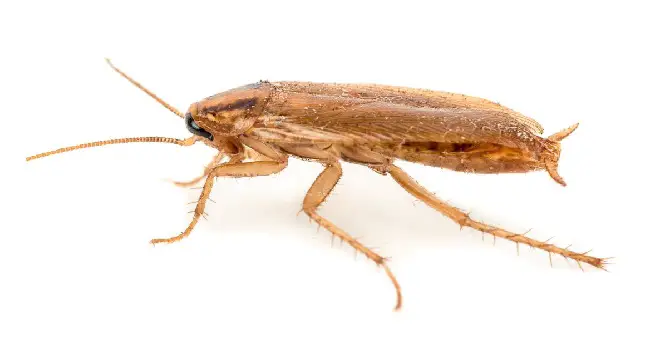Smallest Cockroach In The World

The smallest cockroach on Earth is the Ant Cockroach (Attaphila fungicola). Measuring less than 3 mm, this tiny critter lives not in our houses but within the nests of leafcutter ants, particularly in regions of North America north of Mexico.
The ant cockroach has established a unique symbiotic relationship with its ant hosts. However, the exact nature of this association still needs to be fully understood.
Table For Quick Reference
| Species Name | Max Size | Distinct Features |
|---|---|---|
| Brown-banded Cockroach (Supella longipalpa) | ½ inch | Alternating amber and dark brown markings |
| German Cockroach (Blattella germanica) | ½ inch | Light brown with darker bands |
| Three-lined Cockroach (Luridiblatta trivittata) | ¼ inch | Translucent light brown with three black stripes |
| Field Cockroach (Blattella vaga) | ½ inch | Light brown with darker stripes on the head |
| Pennsylvania Wood (Parcoblatta pennsylvanica) | 1 inch (females slightly smaller) | Males are light brown, females are dark brown |
Five Common Small Cockroaches
Let’s delve deeper into some of the more common small cockroaches you might encounter, particularly those that cohabitate with humans.
Brown-Banded Cockroach

The Brown-Banded Cockroach is a tiny marvel of nature, with a maximum length of just 1/2 inch. Their appearance is characterized by alternating amber and dark brown bands, which makes them easily identifiable.
Originally residents of African regions, these roaches have spread worldwide, making themselves at home in the warmer corners of human dwellings. Preferring temperatures above 80 degrees, they often settle behind picture frames and electrical appliances.
Like most roaches, their diet is diverse, ranging from decaying organic matter to starch-based items like wallpapers or stamps in homes. The female Brown-Banded roach’s reproductive prowess ensures their continued presence, with each egg case she produces containing between 10-18 eggs.
German Cockroach

The German Cockroach is the most notorious household invader among its peers. Light brown with two dark stripes running just behind their head, these roaches rarely grow beyond 1/2 inch. However, their size belies their resilience.
They are particularly adept at finding the coziest spots in human homes, especially in kitchens and bathrooms. A scavenger by nature, this roach has a proclivity for starchy and sugary residues.
But what sets the German cockroach apart is its impressive breeding rate; a single female can produce up to 300 offspring in her lifetime, ensuring their omnipresence in infested areas.
Three-Lined Cockroach

The Three-Lined Cockroach, a petite species with a maximum size of just 1/4 inch, boasts an almost translucent light brown hue decorated with three distinct black stripes.
Native to the Mediterranean, these roaches have expanded their horizons, finding habitats across various continents. They predominantly reside outdoors, playing a beneficial role in the ecosystem by feeding on decaying plant material.
This consumption aids in the natural decomposition process, which enriches the soil. While the specifics of their reproduction remain largely unexplored, their persistent presence across varied regions testifies to their reproductive efficiency.
Field Cockroach

Field Cockroaches are another outdoor-loving species, thriving in areas rich in decaying organic material like leaves and mulch. Growing up to 1/2 inch, these roaches feature a light brown complexion with a slightly darker stripe pattern behind their heads.
Their dietary habits revolve around consuming the very material they live among, aiding the organic recycling process of the ecosystem. The female field roach has a unique maternal trait.
She carries her egg case until the eggs are almost ready to hatch. This method ensures a higher survival rate, sheltering the next generation from external threats until the last possible moment.
Pennsylvania Wood Cockroach

The Pennsylvania Wood Cockroach, also known simply as the wood roach, is more connected to nature than its aforementioned peers. Preferring forested areas, they often refuge under tree bark or in decaying logs.
Males and females exhibit distinct appearances; while males shine in a light brown hue and are capable of short flights, females are darker and possess only rudimentary wings. Their diet mainly comprises decaying wood, breaking down complex plant fibers, and aiding the ecosystem.
Interestingly, their nymphs deviate from the usual white hue seen in other species, bearing a medium brown shade instead, which provides them with the perfect camouflage against wood.
What to Do If You Spot a Small Cockroach?
Spotting a small cockroach in your home can be unsettling, but it’s essential to identify whether you’re looking at a nymph or an adult. A nymph suggests a breeding population, which might require professional extermination. Small roaches can be quick breeders regardless of size, which means prompt action is necessary.

James E. Butkovich, Pest control maven with a knack for eco-friendly & Chemical solutions. Blogger with a mission to make homes pest-free, one post at a time.